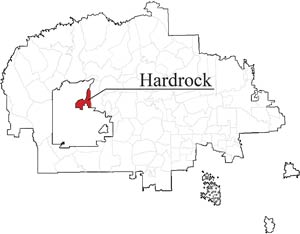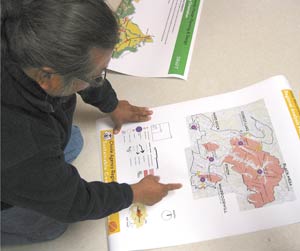Hard rocks, tough people
Hard Rock grapples with the aftermath of relocation
By Cindy Yurth
Tséyi' Bureau
HARD ROCK, Ariz.., April 25, 2013
(Editor's note: In an effort to chronicle the beauty and diversity of the Navajo Nation, as well as its issues, the Navajo Times has committed to visiting all 110 chapters in alphabetical order. This is the 32nd in the series.)


(Times photo — Cindy Yurth)
TOP: Map
SECOND FROM TOP: Newly elected Chapter President Timothy Johnson spreads out planning documents on the floor of his office Thursday. A permaculture instructor, Johnson hopes to bring some of his knowledge to the planning process for his chapter.
THIRD FROM TOP: The rocky outcrops of Hard Rock Chapter have been quarried for building stone since ancient times. Even now, people haul the dense caprock to their homesites for build sturdy foundations.
H ARD ROCK, Ariz. - A lot of Navajo chapters have names so cryptic even the residents can only speculate on their origin. Not so Hard Rock, Tsé Dildo'i in Navajo. It's just what you would expect: for millennia, people have been quarrying the area's rocky outcrops for their exceptionally durable building stone.
But the reality of Hard Rock Chapter is much more complex than its name. It is quite possibly the chapter that lost the most in the Navajo-Hopi land dispute.
Not only did the chapter lose two-thirds of its land area after the Healing v. Jones decision, said newly elected Chapter President Timothy Johnson, but many of its best medicine men and storytellers opted to relocate to government-sponsored housing in other areas.
"When it comes to historical oppression," Johnson said, "I can't think of another chapter that has suffered the way Hard Rock has."
Johnson, by the way, is known hereabouts as the man who beat beloved long-time Chapter President Percy Deal in the last election.
For months after the November election, "people would come up to me and say, 'So you're the guy who beat Percy,'" Johnson recalled. "I told them, 'No, I'm Timothy Johnson. Nice to meet you.'"
Johnson, a permaculture instructor who triples as a security guard and the athletic director at Rock Ridge School, was as surprised as anyone when the votes were counted.
"Here's Percy Deal with his clan all around him," he said. "I'm just an in-law."
That may be a bit modest, since he's been here 30 years and is married into the much-admired Manybeads family, who in 1989 sued the United States government on the grounds the forced relocation violated their religious freedom.
(The case made it all the way to the Supreme Court before it was rejected in 2001, but "it bought some time for the anti-relocation movement," Johnson said.)
Meanwhile, after the land dispute was settled by the courts in 1974, Hard Rock went from one of the Navajo Nation's larger chapters (305,000 acres) to one of its smaller ones (78,100 acres).
"We're almost completely surrounded by Hopi," Johnson said.
A lot of the chapters voters - including Johnson himself and his wife Belinda - live on the Hopi Partitioned Land, either legally with an accommodations agreement, or ... not.
Some of the most famous relocation resisters, including Katherine Smith and Bonnie Whitesinger, live here, along with younger activists like To' Nizhóní Ani founder Nicole Horseherder.
While most chapter houses display photographs of the current tribal president and vice president, Hard Rock's new edifice is proudly festooned with pictures of relocation resisters.
"We've had a lot of struggles," said Johnson, "but it's made us resilient."
Oddly, the people here don't seem to hold anything against their Hopi neighbors.
"We know the dispute was caused by an outside entity," said Johnson, referring to Peabody Western Coal Co., who wanted the land for its Black Mesa Mine, and the U.S. government.
Besides, there's been enough intermarriage between Navajos and Hopis that "it's hard to see it as a 'them' and 'us' thing," Johnson explained. "There's a whole bunch of Navajo-Hopis saying, 'What about us? Where do we fit in?'"
Lately, there is a bit of a rift between the tribes - and when Kykotsmovi and Window Rock are at odds, Hard Rock is the hostage.
For instance, the washout-prone BIA road between Piñon and Hard Rock is ready to be paved.
"Everything's planned and paid for," Johnson said.
But three of the road's 13 miles run through Hopi land, which means the construction needs a nod from the Hopi Tribal Council.
Ever since the Navajos started considering a proposal to develop the confluence of the Colorado and Little Colorado rivers - the Hopis' emergence site - "the Hopis aren't signing anything," Johnson said. "They're pissed off."
Hopi Chairman Leroy Shingoitewa didn't return a phone call to confirm or deny that, but the tribe has issued a statement opposing any development at the Confluence.
Johnson has changed tacks and is instead pressing for improvements to another treacherous road, 8031, that carries both Hopi and Navajo school buses.
"That one would benefit everybody," Johnson said. "It's pretty scary when a school bus slides off the road, whether it's Navajo or Hopi children."
The Hopis and Hard Rock Chapter have also talked about partnering on infrastructure for a planned community called Turquoise Village. The water and electric lines could be shared by Hard Rock residents.
Johnson describes Hard Rock as "an old, old community." Oral history in his wife's family places their clan in the same place for at least five or six generations, and the astounding array of petroglyphs in Horseshoe Canyon attests that people have been living here a lot longer than that.
But it's recent events, specifically the relocation, that define this proud, rugged, hardworking chapter.
From Johnson's perspective as an immigrant from Rock Point, Ariz., the relocation and subsequent resistance has made Hard Rock a land of paradox.
On one hand, the resisters have had to fend for themselves, since the government can't legally provide them services. And yet, sympathizers from all over the world have stepped in to help them.
Johnson affectionately refers to the caravans of young people from Colorado and California who flock to Big Mountain every year as "the hippies."
"They want to learn our ways," he said, "but they also bring us new ways of doing things - permaculture techniques from the outside."
Deprived of many of its spiritual leaders, Hard Rock has hunkered down into the old Navajo religion - but when the AIM folks came to support the struggle and brought the Sun Dance of the Plains tribes with them, the locals were open to it.
"Now there are quite a few Navajo Sun Dancers," Johnson said.
What's the future of this beleaguered chapter? As a permaculture expert, Johnson alternates between optimism and near-despair.
"When you look at the grazing, the land, the water, the housing, health, the school, everything's coming to a bottleneck with sequestration," he said. "Sometimes it really depresses me. But I was in the Marine Corps, and all you hear as a Marine is, 'Improvise!' 'Adapt!'
"That's why Navajos make good Marines."
Hard Rock at a Glance
Name - Hard Rock, or Tsé Dildo'i in Navajo, refers to the stony outcrops quarried for thousands of years as building material. Even today, people haul rock from the ridges to build foundations for their homes.
Population - 1,161
Land area - 78,100 acres. Hard Rock lost nearly two-thirds of its land area when the Navajo-Hopi land dispute was settled.
Major clans - Naakaii Dine'é, Chishi, Tábaahá, 'Ashiihi
Assets - resilient people, exceptional petroglyphs, building stone, a school and trading post
Problems - treacherous dirt roads, feral horses, overgrazing, how to provide for chapter residents residing on Hopi Partitioned Land, shared jurisdiction of roads

